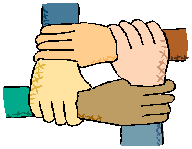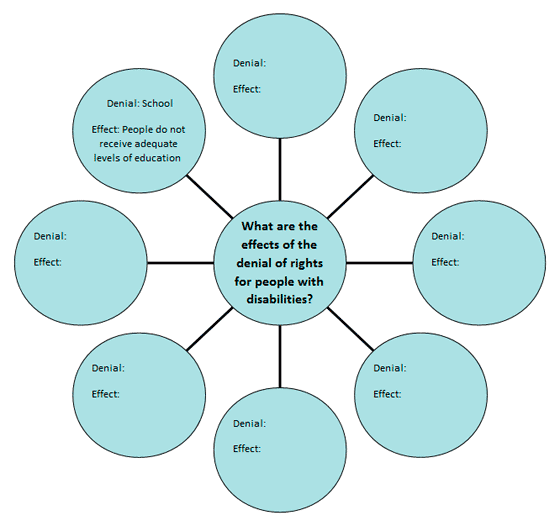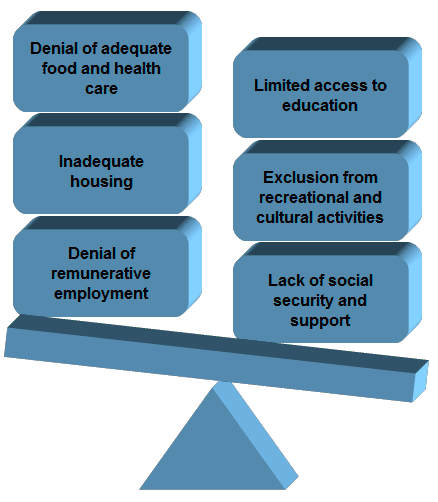ICESCR Training Guide - Module 1: Human Rights and Disability
Facilitator Overview
Introduction
This module looks at the role that human rights play in the lives of people with disabilities.
Description
- 1.1 Defining Human Rights (10 minutes)
- 1.2 Disability and Human Rights (20 minutes)
- 1.3 General Human Rights Principles (20 minutes)
- 1.4 Universality and Indivisibility of Rights (10 minutes)
Time: 60 minutes
Participant Overview
Objectives
In this module, you will have the opportunity to gain an understanding of general human rights principles, and to discuss the role these rights can play in the lives of people with disabilities. By the end of this section you should be able to:
- Understand human rights principles and be able to recognize how they apply to disability
- Know about some of the laws, policies, programs and processes protecting, promoting and fulfilling disability rights
Description
- 1.1 Defining Human Rights (10 minutes)
- 1.2 Disability and Human Rights (20 minutes)
- 1.3 General Human Rights Principles (20 minutes)
- 1.4 Universality and Indivisibility of Rights (10 minutes)
Time: 60 minutes
Section 1.1 – Defining Human Rights
Facilitator Information
- Explore the four groups of rights: Economic, Social, Cultural, Civil and Political with the group.
- Outline the human rights model and the tips for recognizing people with disabilities as rights-holders.
- Let participants know that the broad groups of rights will be discussed again later in the training.
Time: 10 minutes
Human rights can be divided into four broad groups:
Social rights
Social rights improve the well-being and standard of living of all members of society. They give people security as they live together in families, schools, and communities. Some examples include:
- the right to the highest attainable standard of physical and mental health
- the right to adequate housing, food, clothing and water
- the right to inclusive and accessible education
Economic rights
Economic rights deal with income-generating activities or income supports that allow one to secure the necessities of life. Some examples include:
- the right to own property
- the right to social security including social insurance
- the right to earn a living from work that is freely chosen
- the right to equal pay for equal work
- the right to access technical and vocational training programs
Cultural rights
Cultural rights deal with protecting, developing and enjoying one’s cultural identity. Some examples include:
- the right to participate in inclusive culture, arts, recreation, leisure and sport
- the right to create a unique disability culture
- the right to cultural materials in accessible formats
- the right to access places of cultural performances
Civil and Political rights
Civil and political rights allow people to have equal citizenship. Some examples include:
- the right to life, liberty and security of person
- the right to freedom of opinion
- the right to protection from torture and violence
- the right to vote and run for political office
Human rights are indivisible and interdependent. No one type of right is more important than another. For people to be free from fear and want, they must be able to enjoy both their economic, social and cultural rights as well as their civil and political rights.
- Note
- Rights advocates and analysts classify specific rights in different categories. For example, some people prefer to combine social and economic rights into a single category of socio-economic rights. All of the rights listed could fit into several different categories; however, to simplify matters, this guide has separated rights into the abovegroups. This division is intended to make the process of learning about rights and engagement with them easier to understand.
- Human Rights Model
- Disability = dimension of human culture / part of the human tapestry
- Person with Disability = individual with differences entitled to the rights enjoyed by others
- Experts = people with disabilities
- Solutions = recognize that people with disabilities have the same rights as everyone else meaning that human variation must be taken into account by making laws and policies that include everyone
Tips: Recognition of People with Disabilities as Rights Holders Requires that:
- The needs of people with disabilities are not “special”. If someone owns a car and wants to drive on a highway, we don’t say they have a “special” need for a highway. In the same way, if someone has a wheelchair and needs a sidewalk without potholes to move on, that should not be considered a “special” need.
- The issues are politicized. Discrimination and injustice are at work when people with disabilities can’t go to school, don’t get jobs and live in poverty.
- Separate but equal is not equal. Services that limit a person’s freedom or self-determination do not support a person’s autonomy, dignity and rights as a human being.
- People with disabilities have to be recognized as decision-makers. They are not simply the recipients of what others think is good for them. They are independent people who know best what they need and want.

Section 1.2 – Disability and Human Rights
Facilitator Information
- Review the instructions of the activity, ask each participant to complete the chart based on their understanding of the different areas in which people with disabilities are denied human rights.
-
Have participants break into small groups to discuss the effects of these denials. As a group complete the chart on how these denials reflect attitudes and systems. Encourage discussion of different ideas.
- What determines who has access to a right?
- How do issues become politicized?
- What do we mean by “equal”?
- Who is responsible for this kind of decision making?
- Review key areas of the chart at the end of the section entitled 'Key Areas of Disadvantage for People with Disabilities in Canada'
Time: 20 minutes
Activity: Denial of Human Rights
Part 1
Work Individually: List some examples of where people with disabilities are commonly denied their rights.
Example:
- Schools – people with disabilities are often denied their right to education when they are excluded from classrooms and from participating in learning environments with their peers
Where else are people with disabilities commonly denied their rights?
Part 2
Work in small groups: On the chart below using the areas of rights you have identified on the previous page, discuss the effects that this lack of rights may have on people with disabilities.

All human rights apply equally to all persons -- including people with disabilities. However, people with disabilities continue to experience systemic discrimination throughout the world.
Human rights have rarely been implemented in ways that are meaningful to persons with disabilities or ways that reflect their experiences. In the areas of economic social and cultural rights, discrimination against persons with disabilities is common. Persons with disabilities frequently have limited or no access to education, live in severely inadequate housing, are denied adequate necessities such as food and health care, and are often excluded from participation in recreation, cultural activities, and the social life of their communities.
Part 3
Group Discussion: Using the identified barriers below discuss the questions on the right

What do these barriers tell us about attitudes toward disability?
What do the barriers tell us about how systems are organized? (for example the way that government services are provided)
Living Conditions for Persons with Disabilities
Persons with disabilities often have limited or no access to certain rights in their lives, for example: education, housing, necessities such as food and health care, and participation in recreation, cultural activities, and the social life of their communities. Key areas of disadvantage are shown in the table below.
| Area | Comment |
|---|---|
| Employment |
|
| Income |
|
| Education |
|
| Transportation |
|
Source: Participation Activity Limitation Survey (PALS), 2001,2006 Statistics Canada
Section 1.3 – General Human Rights Principles
Facilitator Information
- Briefly outline the five principles of Human Rights (Dignity, Autonomy, Participation, Inclusion & Accessibility, Non-discrimination & Equality and Respect for Difference)
- Ask participants to start to think about what these words mean to them
- Review the instructions of the activity
- Have participants complete the chart in small groups
Time: 20 minutes
In addition to setting out specific rights like “the right to health”, human rights instruments also include general principles that should be considered when applying the instrument. Here are the general human rights principles stated in the Convention on the Rights of Persons with Disabilities and other international human rights instruments that are important to people with disabilities:
-
Dignity
Dignity refers to the inherent worth of every person. Human rights are intended to protect and promote human dignity.
-
Autonomy
Autonomy is the right of an individual to make his or her own choices independently, with adequate and appropriate support where required. Autonomy is about the freedom of an individual to be in charge of his or her own life.
-
Participation, Inclusion & Accessibility
Inclusion involves organizing systems of society, both public and private, to enable all people to participate fully and effectively. To achieve full participation, an accessible, barrier-free physical and social environment is necessary. -
Non-Discrimination & Equality
Non-discrimination means that all rights are guaranteed to everyone, without distinction, exclusion or restriction based on disability or race, sex, language, religion, political or other opinion, national or social origin, property, birth, age, or any other status.Equality, in the context of disability, does not mean being the same, but requires creating societal conditions that allow for difference while addressing disadvantage, in order to guarantee the equal participation and inclusion of people with disabilities in all aspects of society.
-
Respect for Difference
Respect for difference involves acceptance of persons with disabilities as part of human diversity and humanity. Despite some visible or apparent differences, all people have the same rights and dignity.
- Note
- Also see General Comment No. 20 (on discrimination in Economic, Social and Cultural Rights) of the U.N. Committee on Economic, Social and Cultural Rights. Available from the O.H.C.H.R. Website.
- Note
- Words that are marked with an asterisk (*) are defined in the Glossary found in Module 2.
Two additional concepts are crucial to the implementation of Economic, Social and Cultural Rights: a) Progressive Realisation of Rights and b) Maximum Available Resources
The ICESCR states in Article 2(1):
Each State Party to the present Covenant undertakes to take steps, individually and through international assistance and co-operation, especially economic and technical, to the maximum of its available resources, with a view to achieving progressively the full realization of the rights recognized in the present Covenant by all appropriate means, including particularly the adoption of legislative measures. [emphasis added]
This provision recognizes that countries may not be able to realize all of the rights in the ICESCR right away because of a lack of financial resources. Instead, countries can aim to realize certain rights on a step-by-step basis, or 'progressively'.
But, the provision does not allow countries to continue to delay in implementing rights. There is a requirement that countries implement some obligations in the Covenant right away, regardless of the country’s financial situation (e.g. non-discrimination based on sex, race and other grounds, etc.). Also, countries must always continue to make some progress toward realizing rights, that is, continuously taking some steps until the right is fully realized. In addition, once a country’s implementation of rights has reached a certain level, it cannot move backward.
Activity: Human Rights in Your Life
Write down an example from your own life in each area where these human rights principles have been demonstrated
- Dignity
- Autonomy
- Participation
- Non-Discrimination and Equality
- Respect for Difference
- Example of Dignity
- Mirela has a psychiatric disability. She has had difficulty holding a job and is very poor. She is not forced to live in an institution or beg for money. Instead, the government provides her with the income support she requires to meet her basic needs.
- Example of Autonomy
- Robert has speech that is difficult to understand. He is provided with the services of a communication assistant when visiting the doctor so that he can ask questions and make decisions about his treatment.
- Example of Participation, Inclusion & Accessibility
- Priyanga who is blind is able to attend the same school and classes as her brothers and sisters who are not blind.
- Example of Non-Discrimination and Equality
- Taylor, a woman with dyslexia, is admitted to university based on her qualifications and not over-looked because of her disability.
- Example of Respect for Difference
- Eghosa has a disability that requires him to walk with a cane. In order to remain mobile and self-sufficient, his community transit system is essential. The bus driver on Eghosa’s regular route recognizes his needs and allows him time to walk from the bench where he waits to the bus. In addition, the driver allows Eghosa the extra few seconds it takes to reach his seat before starting to move the bus.
Section 1.4 – Universality and Indivisibility of Rights
Facilitator Information
- Explain the meaning of universality
- Review the instructions of the activity; ask participants to work in pairs to complete the chart looking at whether human rights are universal in practice?
-
Review the Indivisibility of Rights. Ask participants:
- What does indivisibility mean to you?
- How can you see rights overlapping?
Time: 10 minutes
Universality of Rights
Human rights are universal; they apply to everyone equally. It is important to note that human rights are the same everywhere regardless of culture, religion, customs or ideology.
- All rights and entitlements are interrelated and interdependent based on one principle: human dignity
- No rights have priority over other rights. For example economic rights do not have priority over political rights nor political over economic rights.
Source: Stream 4: Seeking Common Ground
Activity: Universality of Rights
In pairs answer the following question in the chart below. How might Culture, Economics, and Religion influence understandings of the ways that rights are applied to everyone equally?
- Culture (understandings of gender roles and the equal rights of men and women):
- Economics (ideas about who should receive social assistance and how much):
- Religion (religious beliefs about disability, for example, that persons with disabilities should receive charity):
Indivisibility of Rights
Awareness of the indivisibility and interdependence of rights is important for an understanding of cultural, economic and social rights. Each type of right is linked with other rights. For example:
- Social rights have important cultural dimensions. The right to food [a social right], for example, has many elements that are related to a person’s culture, such as the choice of food, agricultural practices, preparation methods, and how the food is eaten.
- The right to education [a social right] has a close connection to culture since education plays a significant role in the continuation of a culture and in teaching cultural values.
- Economic rights relate to adequate housing [a social right] and can involve cultural elements including: location of housing (urban or rural), types of housing structures (apartment, house, single family/ multi-family).
- Health facilities and services must be respectful of medical ethics and culturally appropriate. Traditional health practices [a social right] are also part of cultural identity. Human rights advocacy strategies must pay close attention to the cultural context.
